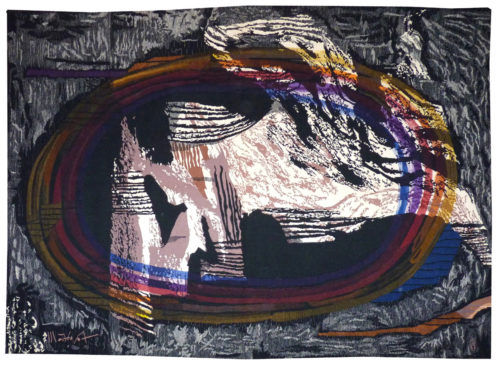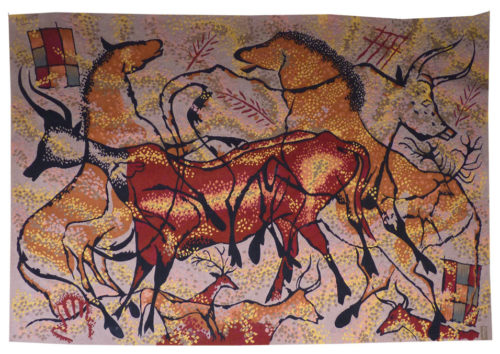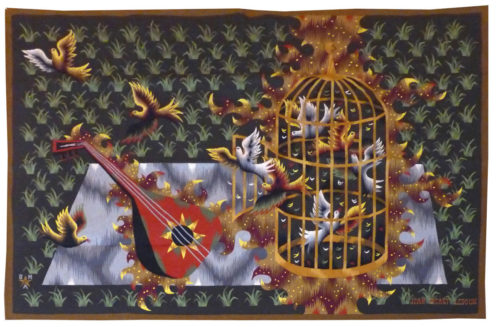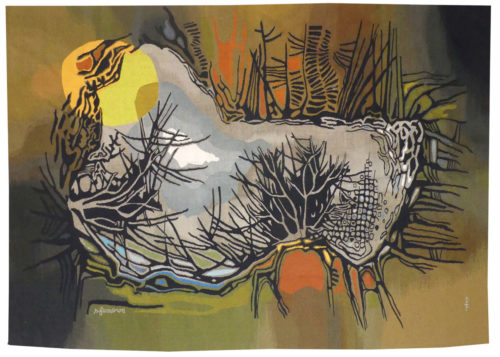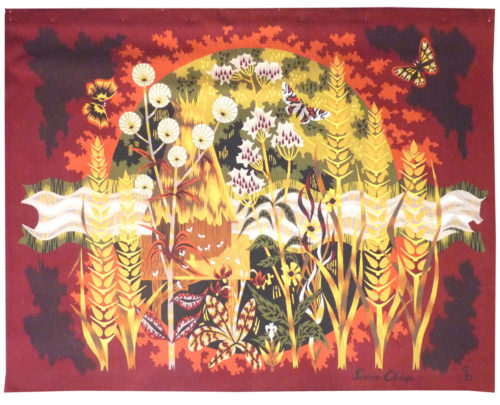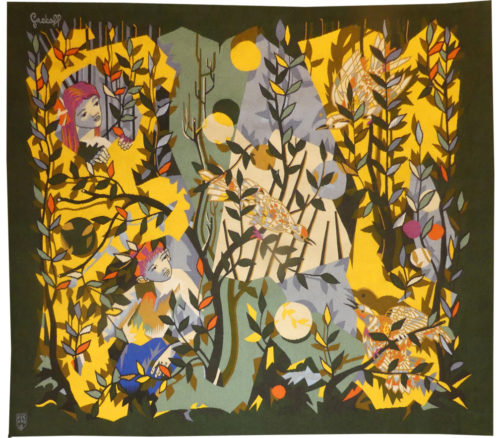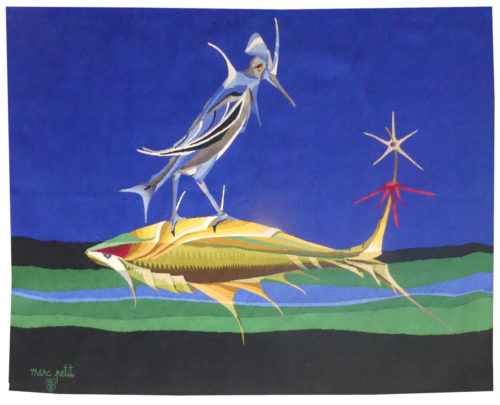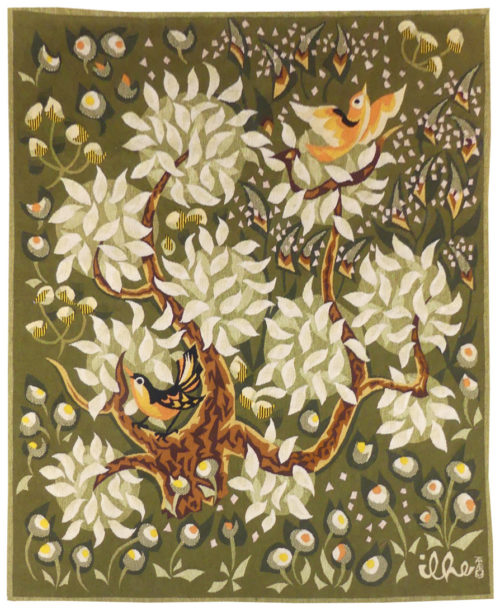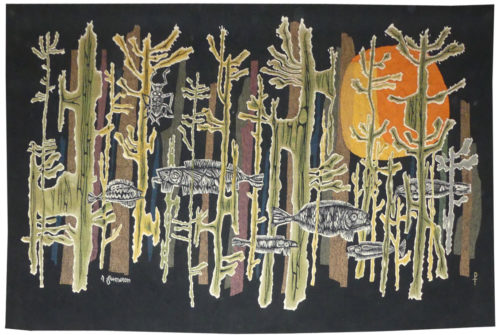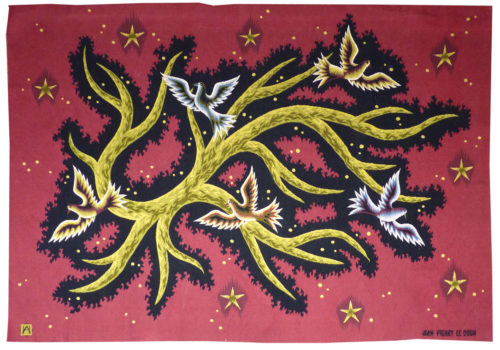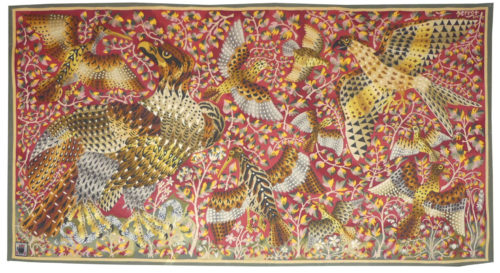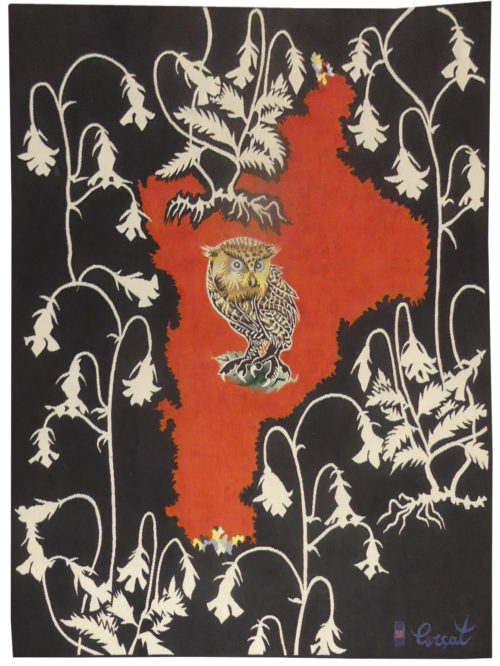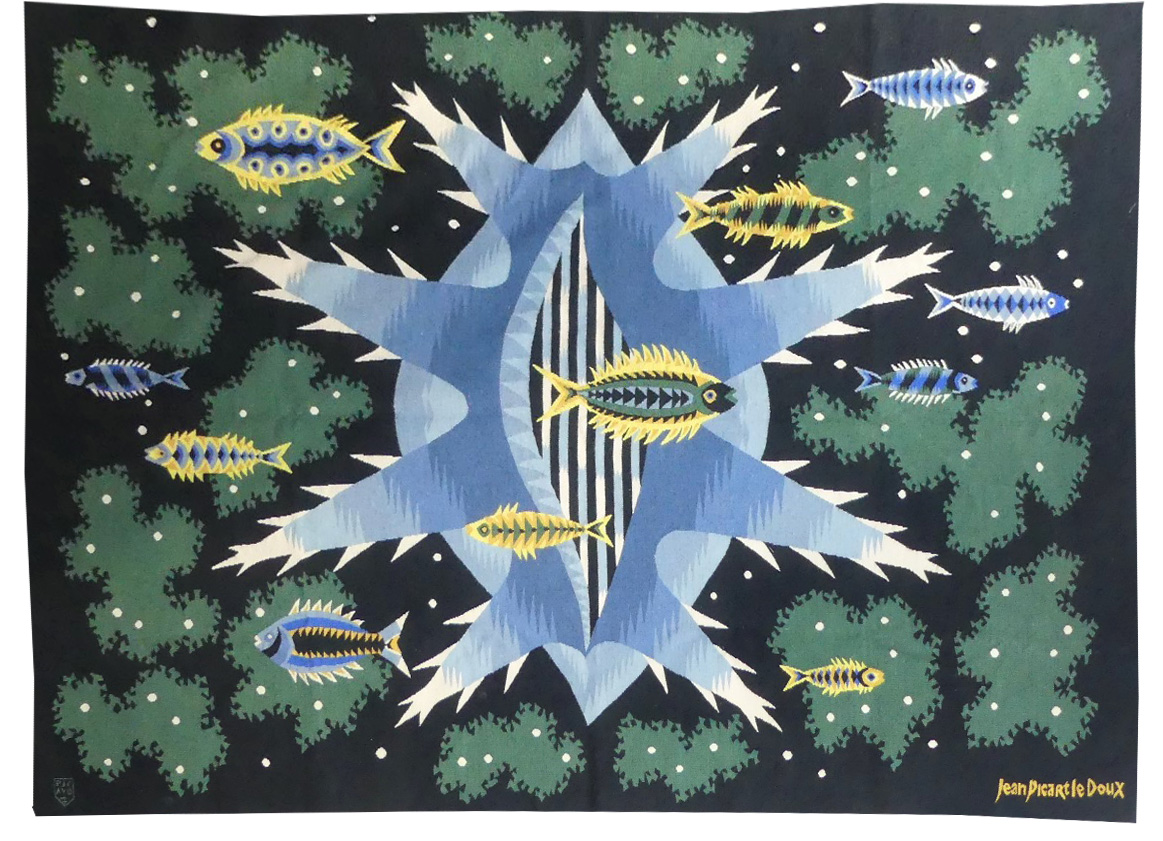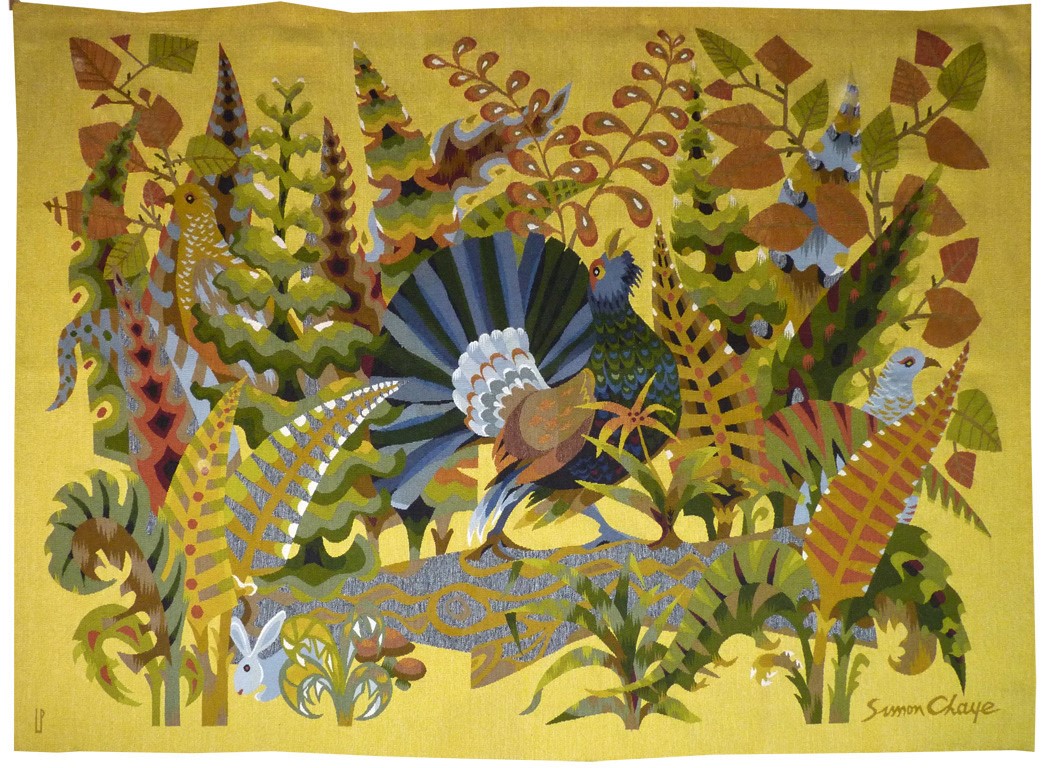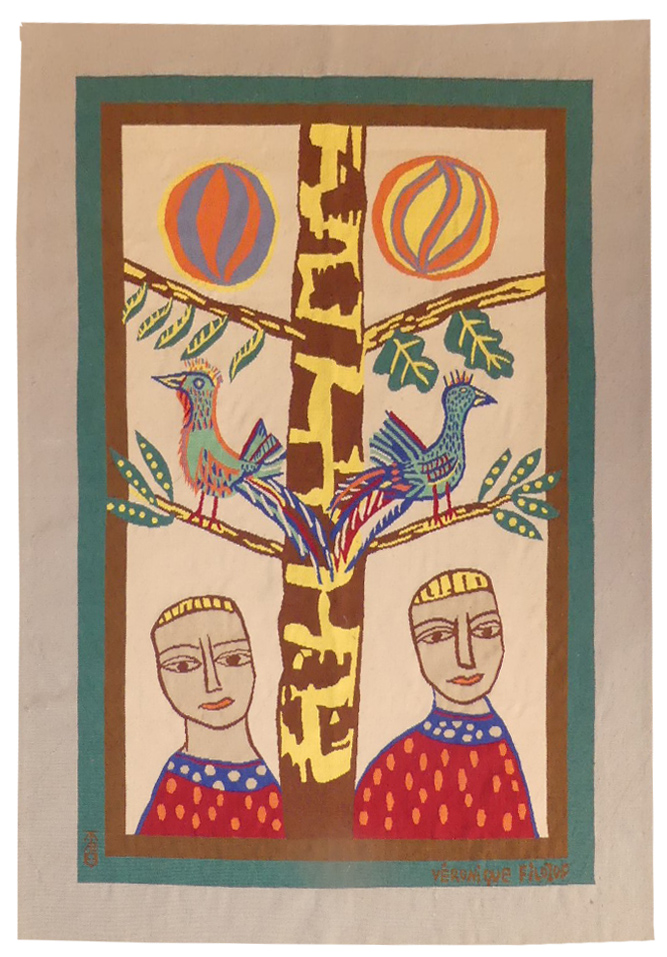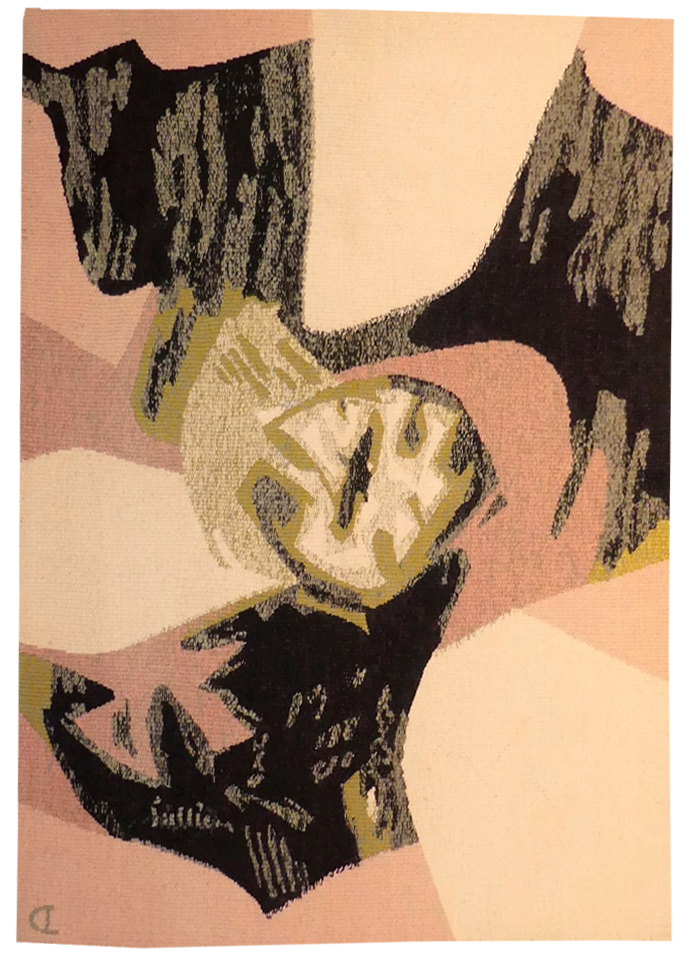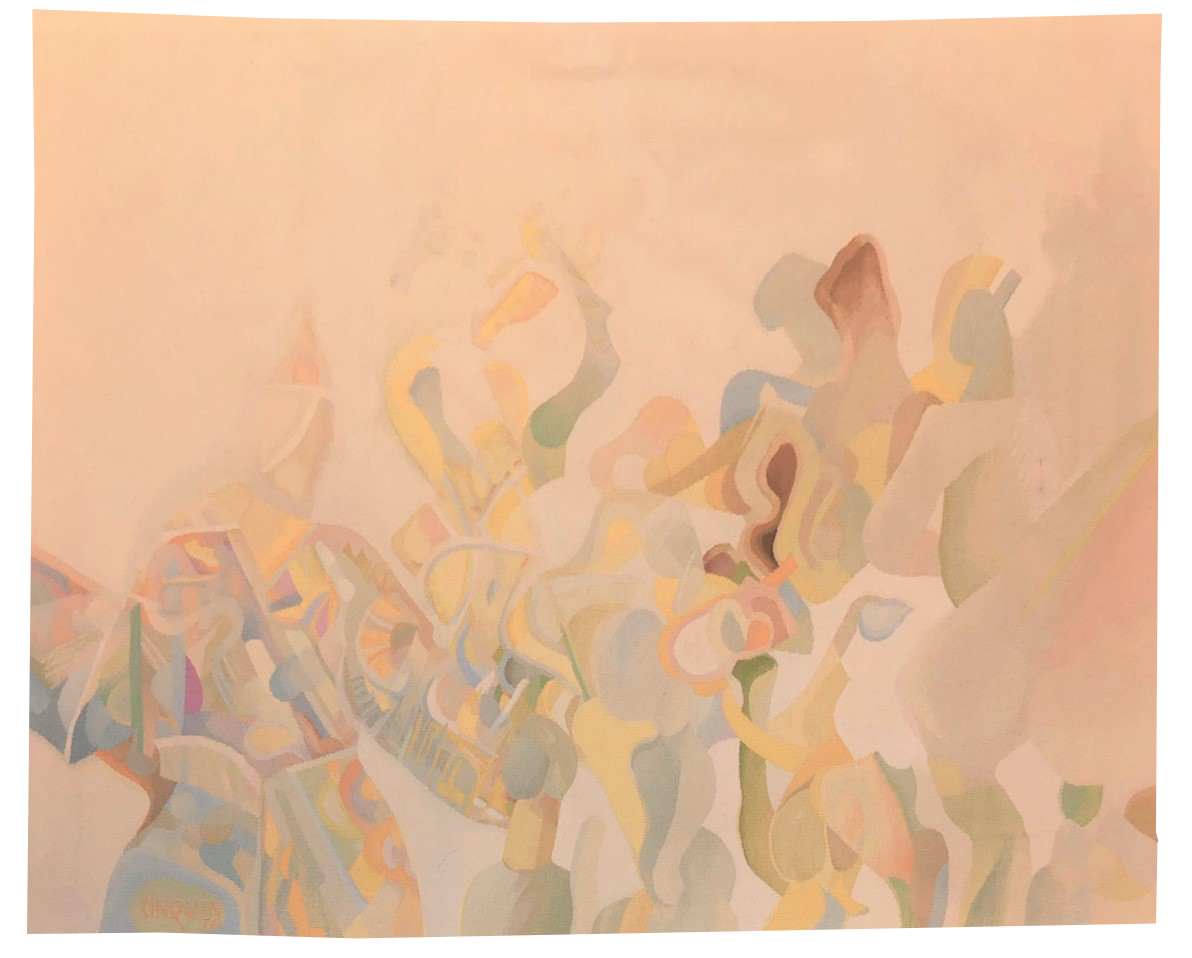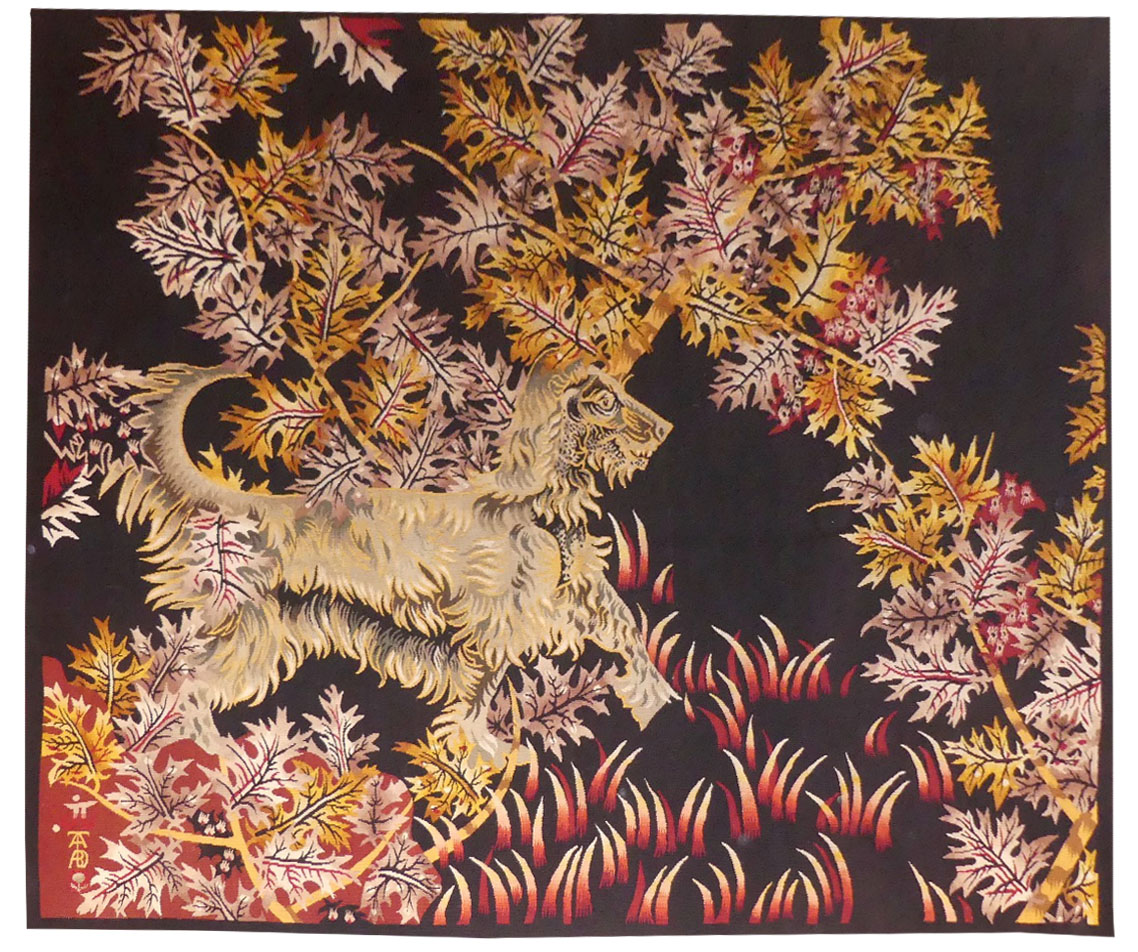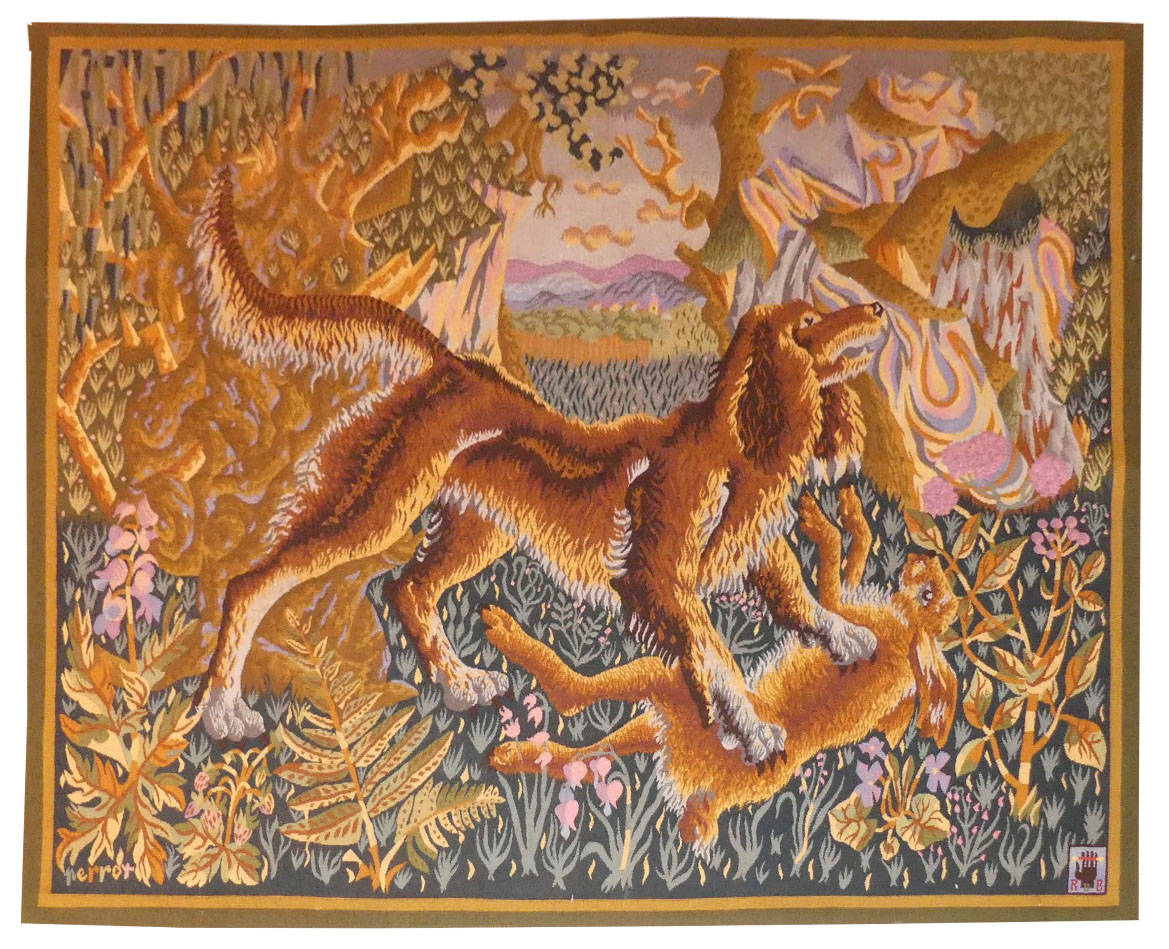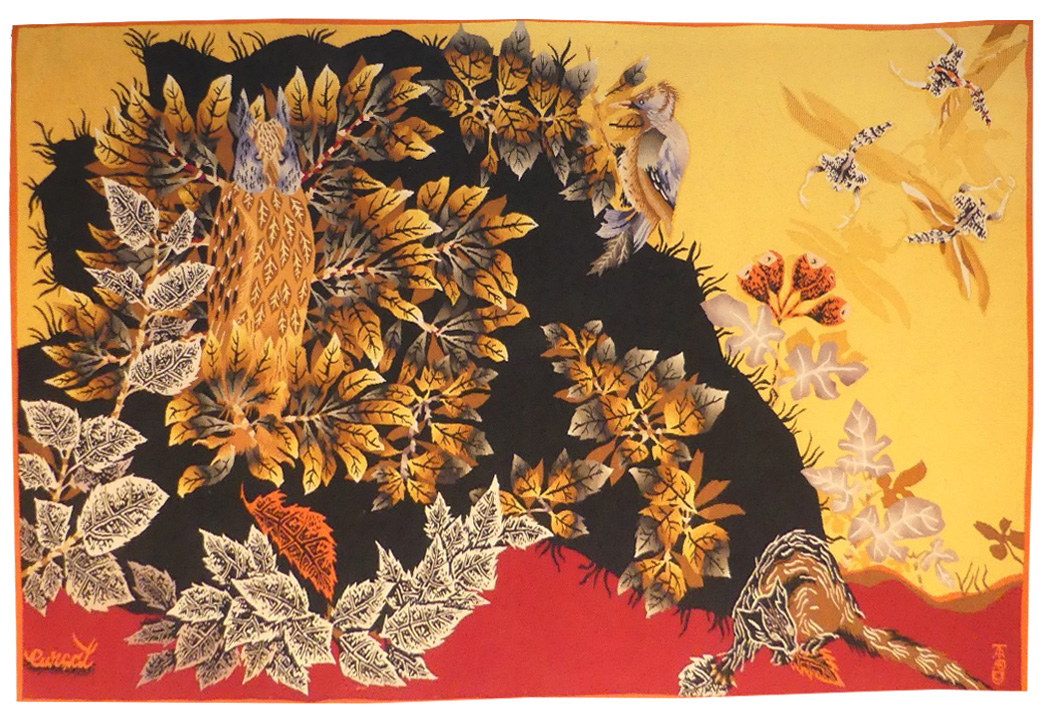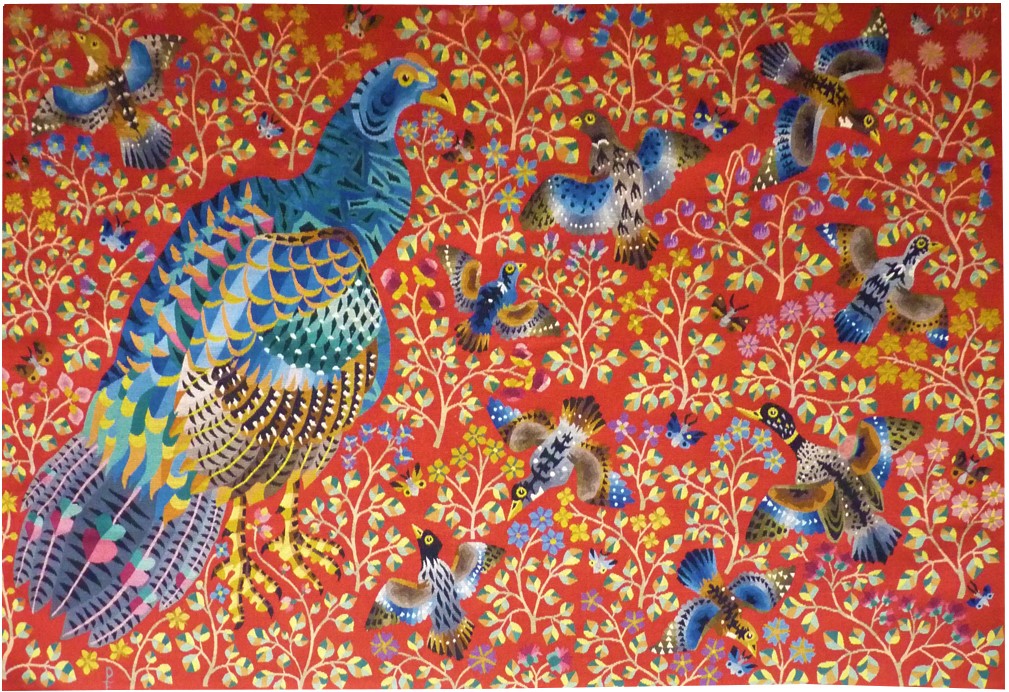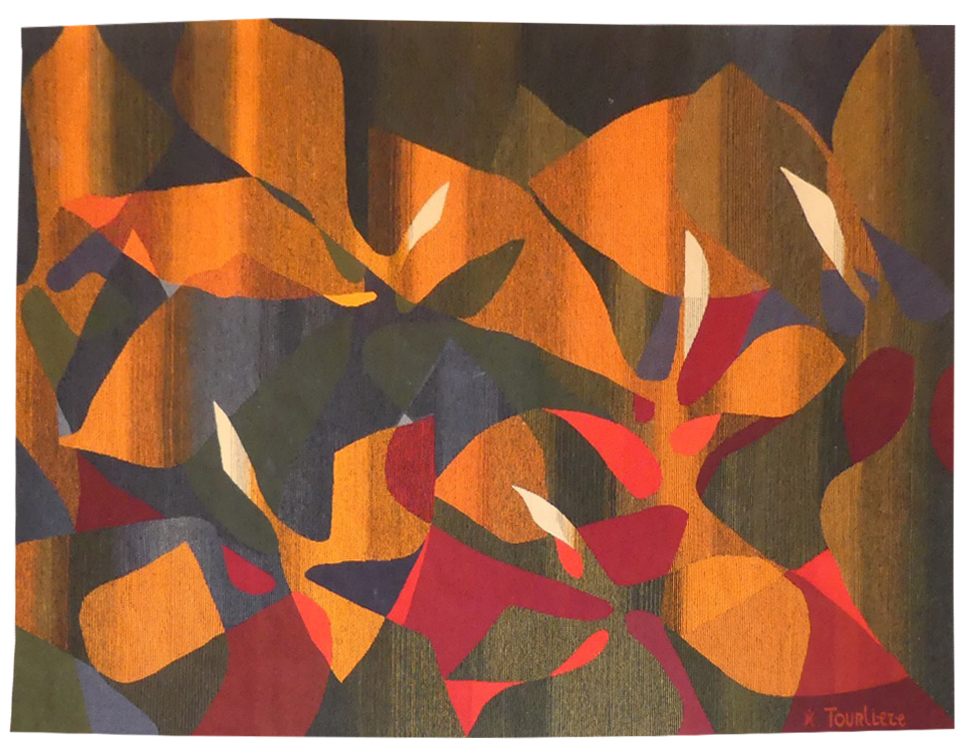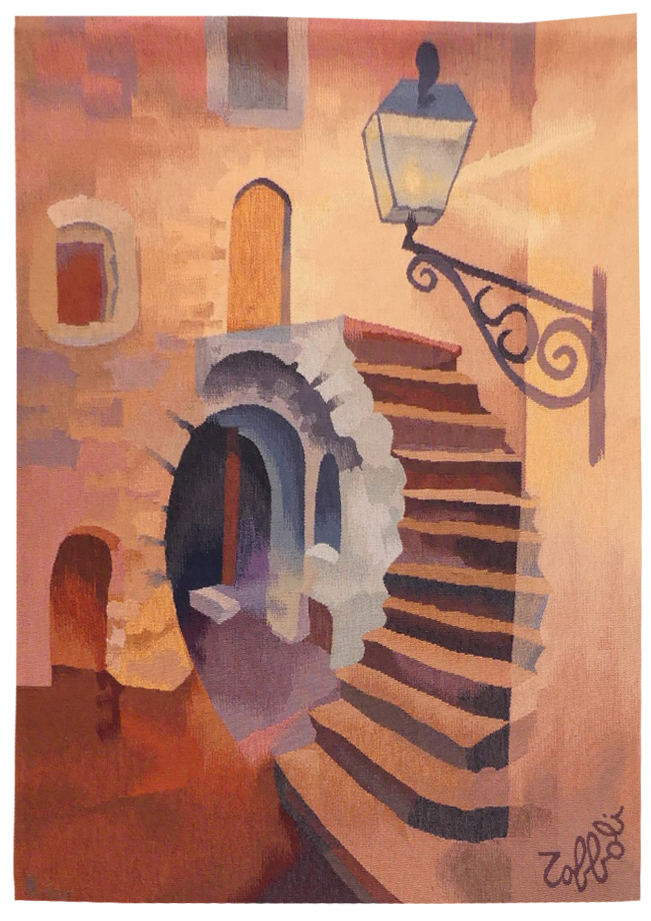-
Hommage à l'abbé Breuil (a tribute to Father Breuil)
Aubusson tapestry woven by the Pinton workshop. Complete with certificate of origin. Circa 1955. Perrot began his career as a cartoon designer at the end of the war, making almost 500 cartoons including numerous commissions from the state, most of which were woven at Aubusson. His style which is particularly rich and decorative is eminently recognisable : a crowd of butterflies or birds, most often, stands out against a background of vegetation, reminiscent of the millefleurs tapestries (which would also inspire Dom Robert). Uncharacteristic cartoon whose inspiration lies in the cave paintings at Lascaux ; here it can be said that never has a tapestry merited quite so well the term « wall art ». Perrot’s input is, in the end, relatively modest : the use of saturated colours (particularly the mauve-pink background), the overlapping of the motifs (which are more spaced out in the cave itself), superficial laid over blotching,... If Perrot is an habitué of hommage-cartoons (Pergaud, Redouté, Audubon,...) this particular example is interesting because of the well-established proximity between the artist and the dedicatee, “the Pope of Prehistory”: here the hommage owes nothing to the artificiality of an official commission. Bibliography : Tapisseries, dessins, peintures, gravures de René Perrot, Dessein et Tolra, 1982 -
Le luth et les colombes (the lute and the doves)
Aubusson tapestry woven in the Berthaut workshop. Complete with certificate of origin signed by the artist, n°6/8. Circa 1955. Jean Picart le Doux is one of the foremost figures in the renaissance of the art of tapestry. His earliest contributions to the field date back to 1943 when he designed cartoons for the passenger ship “la Marseillaise”. A close associate of Lurçat, whose theories he would adopt (limited palette, numbered cartoons...), he was a founding member of the A.P.C.T. (Association des Peintres-cartonniers de Tapisserie), and soon after, a teacher at the Ecole Nationale Supérieure des Arts Décoratifs. The state gave him several commissions most of them at the Aubusson workshop, and some at the Gobelins : the most spectacular of these being for the University of Caen, the Theatre in Le Mans, the passenger ship France or the Prefecture of the Creuse département ... In as much as Picart le Doux’s aesthetic is close to that of Lurçat, so also is his inspiration and his subject matter, although in a register which is more decorative than symbolic, where he brings together heavenly bodies (the sun, the moon, the stars...), the elements, nature (wheat, vines, fish, birds...), man, literary quotation ... The lute and the doves is a reworking of a larger and more densely decorated cartoon dating from 1949 and titled “les oiseaux s’envolent” (the flight of the birds) which was intended as a symbolic representation of the Liberation of France, a theme which recurrs in the “la cage ouverte’ (the open cage) in 1953. Bibliography : Marthe Belle-Jouffray, Jean Picart le Doux, Publications filmées d’art et d’histoire, 1966, ill. n°3 Maurice Bruzeau, Jean Picart le Doux, Murs de soleil, Editions Cercle d’art, 1972 Exhibition Catalogue, Jean Picart le Doux, tapisseries, Musée de Saint-Denis, 1976 Exhibition Catalogue Jean Picart le Doux, Musée de la Poste, 1980 -
Fumeron designed his first cartoons (he would ultimately make over 500) in the 1940’s, in collaboration with the Pinton workshop, he was then commissioned on numerous occasions by the state before participating in the decoration of the ocean liner “France”. His work was figurative to begin with and influenced by Lurçat, then turned towards abstraction, before coming back to a style characterised by colourful figurative and realistic depictions from the 1980’s onwards. Strangely enough, despite the naturalistic title, the cartoon leans towards abstraction in a kind of refinement of Fumeron’s figurative cartoons where we can still recognise the circular yellow-sun characteristic of the artist.Aubusson tapestry woven in the Pinton workshop. With label. Circa 1960.
-
L’enclos (Enclosure)
Aubusson tapestry woven in the Brivet workshop. With signed label, n°4/4. 1966.It was in 1953 that Jean Picart le Doux proposed to Chaye to become his assistant and encouraged him to design tapestry cartoons : he would produce numerous bucolic cartoons, but also views of Normandy (Mont Saint Michel, Honfleur, regattas,...) from whence he came. Here is a thoroughly characteristic cartoon of this artist who specialises in pastures, hedges and woodland scenes. -
Le petit oiseleur (the little bird-catcher)
Aubusson tapestry woven by the Picaud workshop. With label, n°1/6. Circa 1970.Elie Grekoff, whose aesthetic is similar to that of Lurçat, designed over 300 cartons.“The little bird catcher” is typical of a vein characteristic of Grekoff where melancholic children consider each other within a dream-like landscape against a background of large flat areas of colour, redolent of an illustration for a folk tale. -
Le réviseur (the reviser)
Aubusson tapestry woven by the Picaud workshop. With label, n°1/8. Circa 1980. Marc Petit met Jean Lurçat in 1954, went to Aubusson in 1955, exhibited his work for the first time at La Demeure in 1956, became a member of the A.P.C.T. (Association des Peintres-Cartonniers de Tapisserie) in 1958. After this lightning start to his career, he produced hundreds of cartoons, in a style all his own, where long-legged waders and acrobats wend in and out of dreamscapes. An amusing design, which could be interpreted as the illustration of the antithesis of an author and his editor : here depicted by the curious association of a bird and a fish, in an extremely lively colour scheme. -
Matines (matins)
Henri Ilhe, who came to the design of tapestry cartoons late on in his career, still managed to produce from 1964 onwards a considerable number (more than 120, all woven by the Tabard workshop) in an urbane style, incorporating birds and butterflies sporting in and around the gnarled branches of trees and bushes. The title of this piece evokes a certain community of spirit with Dom Robert in the mingling of rural concerns and monastic life.Aubusson tapestry woven in the Tabard workshop. With signed label, n°5. Circa 1970. -
Soleil de corail (coral sun)
Aubusson tapestry woven in the Pinton workshop. With signed label. Circa 1960.Fumeron designed his first cartoons (he would ultimately make over 500) in the 1940’s, in collaboration with the Pinton workshop, he was then commissioned on numerous occasions by the state before participating in the decoration of the ocean liner “France”. His work was figurative to begin with and influenced by Lurçat, then turned towards abstraction, before coming back to a style characterised by colourful figurative and realistic depictions from the 1980’s onwards. The vertical fronds, through which mottled fish weave in and out, partially hide a flaming red sun : in this piece we recognise all the elements of Fumeron’s characteristically fantastical vision. -
La branche (the branch)
Aubusson tapestry woven by the Hamot workshop. Complete with certificate of origin signed by the artist. 1961. Jean Picart le Doux is one of the foremost figures in the renaissance of the art of tapestry. His earliest contributions to the field date back to 1943 when he designed cartoons for the passenger ship “la Marseillaise”. A close associate of Lurçat, whose theories he would adopt (limited palette, numbered cartoons...), he was a founding member of the A.P.C.T. (Association des Peintres-cartonniers de Tapisserie), and soon after, a teacher at the Ecole Nationale Supérieure des Arts Décoratifs. The state gave him several commissions most of them at the Aubusson workshop, and some at the Gobelins : the most spectacular of these being for the University of Caen, the Theatre in Le Mans, the passenger ship France or the Prefecture of the Creuse département ... In as much as Picart le Doux’s aesthetic is close to that of Lurçat, so also is his insipiration and his subject matter, although in a register which is more decorative than symbolic, where he brings together heavenly bodies (the sun, the moon, the stars...), the elements, nature (wheat, vines, fish, birds...), man, literary quotation ... A cartoon (Bruzeau n° 111) which is typical of the artist in the way it combines the animal and plant kingdoms. The realistic treatment of the bark is in strong contrast with the stylised graphic and dream-like nature of the composition. Bibliography : Maurice Bruzeau, Jean Picart le Doux, Murs de soleil, Editions Cercle d’art, 1972 Exhibition catalogue Jean Picart le Doux, Musée de la Poste, 1980 -
La loi (Law)
Aubusson tapestry woven by the Rivière des Borderies workshop. With label. 1951.Perrot began his career as a cartoon designer at the end of the war, making almost 500 cartoons including numerous commissions from the state, most of which were woven at Aubusson. His style which is particularly rich and decorative is eminently recognisable : a crowd of butterflies or birds, most often, stands out against a background of vegetation, reminiscent of the millefleurs tapestries (which would also inspire Dom Robert). Ornithological representations in all their various manifestations are extremely common in Perrot’s work : for example “la discorde” and “la méditation” designed for the Palais de Justice (High Court) in Paris which are illustrated respectively by grouse and owls. What else to illustrate “La Loi” and inspire respect in the observor than the severe glare of a majestic eagle. Bibliography : Tapisseries, dessins, peintures, gravures de René Perrot, Dessein et Tolra, 1982 -
La nuit s'ouvre (Night opens)
Lurçat’s artistic production was immense: it is however his role as the renovator of the art of tapestry design which ensures his lasting renown. As early as 1917, he started producing works on canvas, then in the 20’s and 30’s, he worked with Marie Cuttoli. His first collaboration with the Gobelins workshop dates back to 1937, at the same time he discovered the tapestry of the Apocalypse which was essential in his decision to devote himself to tapestry design. He first tackled the technical aspects with François Tabard, then on his installation at Aubusson during the war, he established his technique: broad point, a simplified palette, outlined cartoons with colours indicated by pre-ordained numbers. A huge production then follows (over 1000 cartoons) amplified by his desire to include his painter friends, the creation of the A.P.C.T. (Association des Peintres-Cartonniers de Tapisserie) and the collaboration with the art gallery La Demeure and Denise Majorel, and then by his role as a tireless advocate for the medium around the world. His tapestries reveal a pictorial world which is specifically decorative, with a very personal symbolic iconography : cosmogony (the sun, the planets, the zodiac, the four elements…) stylised vegetation, fauna (rams, cocks, butterflies, chimera …) standing out against a background without perspective (voluntarily different from painting) and, in his more ambitious work, designed as an invitation to share in a poetic (he sometimes weaves quotations into his tapestries) and philosophical (the grand themes are broached from the wartime period onwards) vision whose climax is the “Chant du Monde” (Song of the World) (Jean Lurçat Museum , ancien hôpital Saint Jean, Angers) which remained unfinished at his death. Here stylised vegetation, white on a black background (as in Talbot’s photogrammes), appears as if torn to reveal a red stain against which is framed an owl : the title suggests hope, however the cartoon announces by its mutedness “the end of everything” as in the “Chant du Monde”. A similar piece is conserved at the Atelier-Musée des Tours Saint Laurent, in Saint-Céré. Bibliography : Cat. Expo. La tapisserie française, Musée d’art moderne, Paris, 1946 Claude Roy, Jean Lurçat, Pierre Cailler Editeur, 1956, ill. n°113 Cat. Expo. Jean Lurçat tapisseries nouvelles, Maison de la Pensée Française, 1956, n°6 Tapisseries de Jean Lurçat 1939-1957, Pierre Vorms Editeur, 1957, ill. n°109 Cat. Expo. Jean Lurçat, tapisseries de la fondation Rothmans, Musée de Metz, 1969 Cat. Expo. Lurçat, 10 ans après, Musée d’Art moderne de la ville de Paris, 1976, ill. Cat. Expo. Les domaines de Jean Lurçat, Angers, Musée Jean Lurçat et de la tapisserie contemporaine, 1986 Colloque Jean Lurçat et la renaissance de la tapisserie à Aubusson, Aubusson, Musée départemental de la Tapisserie, 1992 Cat. Expo. Dialogues avec Lurçat, Musées de Basse-Normandie, 1992 Cat. Expo. Jean Lurçat, Donation Simone Lurçat, Académie des Beaux-Arts, 2004 Gérard Denizeau, Jean Lurçat, Liénart, 2013, ill. n°131 I. Rooryck, Atelier-Musée départemental Jean Lurçat, 2015, ill. p.14 Cat. Expo. Jean Lurçat, Meister der französischen Moderne, Halle, Kunsthalle, 2016 Cat. Expo. Jean Lurçat au seul bruit du soleil, Paris, galerie des Gobelins, 2016Tapestry woven in the Simone André workshop. With label. Circa 1955. -
Coquillage étoilé II (Starry seashell II)
Aubusson tapestry woven by the Picaud workshop. With label signed by the artist, n°2/6. Circa 1975. Jean Picart le Doux is one of the foremost figures in the renaissance of the art of tapestry. His earliest contributions to the field date back to 1943 when he designed cartoons for the passenger ship “la Marseillaise”. A close associate of Lurçat, whose theories he would adopt (limited palette, numbered cartoons...), he was a founding member of the A.P.C.T. (Association des Peintres-cartonniers de Tapisserie), and soon after, a teacher at the Ecole Nationale Supérieure des Arts Décoratifs. The state gave him several commissions most of them at the Aubusson workshop, and some at the Gobelins : the most spectacular of these being for the University of Caen, the Theatre in Le Mans, the passenger ship France or the Prefecture of the Creuse département ... In as much as Picart le Doux’s aesthetic is close to that of Lurçat, so also is his inspiration and his subject matter, although in a register which is more decorative than symbolic, where he brings together heavenly bodies (the sun, the moon, the stars...), the elements, nature (wheat, vines, fish, birds...), man, literary quotation ... « Coquillage étoilé » (Starry seashell) dates from 1959 and thenceforth the motif reappears regularly, in « l’Eau et le Feu » (Water and Fire) (1959), « la Mer et la Terre » (Sea and Land) (1960) or « l’Homme et la Mer » (The man and the sea) (1964)… as an evocation of the sea. This cartoon places the motif at the centre whilst another tapestry, with the same name, uses a vertical format. Bibliography : Marthe Belle-Joufray, Jean Picart le Doux, Publications filmées d’art et d’histoire, 1966 Maurice Bruzeau, Jean Picart le Doux, Murs de soleil, Editions Cercle d’art, 1972 Exhibition Catalogue, Jean Picart le Doux, tapisseries, Musée de Saint-Denis, 1976 Exhibition Catalogue Jean Picart le Doux, Musée de la Poste, 1980 -
Le grand tétras (Capercaillie)
Aubusson tapestry woven by the Legoueix workshop. With signed label, n°2/6. Circa 1970. It was in 1953 that Jean Picart le Doux proposed to Chaye to become his assistant and encouraged him to design tapestry cartoons : he would produce numerous bucolic cartoons, but also views of Normandy (Mont Saint Michel, Honfleur, regattas,…) from whence he came. Here is a thoroughly characteristic cartoon of this artist who specialises in pastures, hedges and woodland scenes. -
Fleurs et feuilles (flowers and leaves)
Multi-talented artist (poet, lyricist, painter and even antiques dealer,…) Saint-Martin, who assisted Lurçat at the beginning of the 1950’s, started designing his own cartoons in 1956 and they were woven in the Braquenié workshop. His is a dream-like, stylised and dramatised world : here, symbols of order and discipline (the still life composition, the wrought iron balustrade...) contrast with the unsettling, unfettered profusion of the branches on each side.Aubusson tapestry woven by the Braquenié workshop. With label. Circa 1960. -
A chacun son soleil à chacun sa lumière (To each his sun to each his light)
Essentially known to the artistic community for her ink drawings and illustrations, Filozof is proof of the variety of artists whose work has been woven in Aubusson over the years. Although the naïf style (or one which is at least influenced by folk art) is hardly over-represented (but we can mention here Mady de la Giraudière) : 8 of her designs have been woven by Tabard.Aubusson tapestry woven by the Tabard workshop. With label. Circa 1960. -
Au coeur de l'ombre (At the heart of darkness)
After the traditional completion of some mural paintings in the 1930’s, he then arrived in Aubusson in 1936, became closely associated with Picart le Doux in 1947 and then joined the A.P.C.T. (Association des Peintres-Cartonniers de Tapisserie). From then on he devoted himself to tapestry with zeal and designed 167 cartoons, at first figurative following on from Picart le Doux and Saint-Saëns, then, influenced by the scientific themes that he dealt with, tending more towards abstraction. In 1981, two years before his death, he donated his studio to the Musée départemental de la tapisserie in Aubusson. This cartoon (the only one dating from 1971) is a prelude to 1972, the year of the « ombres » “shadows” : every 13th cartoon he designs that year has the word in its title; a possible reference to the contemporaneous design of stained glass windows for the temple (protestant church) in Villefavard. Bibliography : Exhibition catalogue Hommage à Louis-Marie Jullien, Aubusson, Musée départemental de la Tapisserie, 1983, n°148 (the model is illustrated)Aubusson tapestry woven in the Legoueix workshop. With signed label, n°1/3 (and handwritten note "tirage arrêté 1/2" [stopped edition 1/2]). 1971. -
Le clown (the clown)
Aubusson tapestry woven by the Hecquet workshop. With signed label, n°1/1. 1974. -
Le chien vert (the green dog)
Lurçat’s artistic production was immense : it is however his role as the renovator of the art of tapestry design which ensures his lasting renown. As early as 1917, he started producing works on canvas, then in the 20’s and 30’s, he worked with Marie Cuttoli. His first collaboration with the Gobelins workshop dates back to 1937, at the same time he discovered the tapestry of the Apocalypse which was essential in his decision to devote himself to tapestry design. He first tackled the Gobelins, 2016technical aspects with François Tabard, then on his installation at Aubusson during the war, he established his technique : broad point, a simplified palette, outlined cartoons with colours indicated by pre-ordained numbers. A huge production then follows (over 1000 cartoons) amplified by his desire to include his painter friends, the creation of the A.P.C.T. (Association des Peintres-Cartonniers de Tapisserie) and the collaboration with the art gallery La Demeure and Denise Majorel, and then by his role as a tireless advocate for the medium around the world. His tapestries reveal a pictorial world which is specifically decorative, with a very personal symbolic iconography : cosmogony (the sun, the planets, the zodiac, the four elements…) stylised vegetation, fauna (rams, cocks, butterflies, chimera …) standing out against a background without perspective (voluntarily different from painting) and, in his more ambitious work, designed as an invitation to share in a poetic (he sometimes weaves quotations into his tapestries) and philosophical (the grand themes are broached from the wartime period onwards) vision whose climax is the “Chant du Monde” (Song of the World) (Jean Lurçat Museum , ancien hôpital Saint Jean, Angers) which remained unfinished at his death. Something of a dog lover, Lurçat owned Afghan hounds. They can be found literally in his cartoons, the theme of the dog, always surrounded by sharp foliage, was omnipresent at the end of the 1940s: ‘Chien vert’ is particularly close to the contemporary ‘Basset’. Bibliography : Tapisseries de Jean Lurçat 1939-1957, Pierre Vorms Editeur, 1957 Exhibition Catalogue Jean Lurçat, Nice, Musée des Ponchettes, 1968 Exhibition Catalogue Lurçat, 10 ans après, Musée d’Art moderne de la ville de Paris, 1976 Exhibition catalogue Les domaines de Jean Lurçat, Angers, Musée Jean Lurçat et de la tapisserie contemporaine, 1986 Symposium Jean Lurçat et la renaissance de la tapisserie in Aubusson, Aubusson, Musée départemental de la tapisserie 1992 Exhibition Catalogue Dialogues avec Lurçat, Musées de Basse-Normandie, 1992 Exhibition catalogue Jean Lurçat, Donation Simone Lurçat, Académie des Beaux-Arts, 2004 Jean Lurçat, le chant du monde Angers 2007 Gérard Denizeau, Denise Majorel, une vie pour la tapisserie, Aubusson, Musée départemental de la tapisserie Gérard Denizeau, Jean Lurçat, Liénart, 2013 Exhibition Catalogue Jean Lurçat, Meister der französischen Moderne, Halle, Kunsthalle, 2016, ill. p.76 Exhibition Catalogue Jean Lurçat au seul bruit du soleil, Paris, galerie des Gobelins, 2016 Exhibition Catalogue Jean Lurçat, la terre, le feu, l’eau, l’air, Perpignan, Musée d’art Hyacinthe Rigaud, 2024Aubusson tapestry woven in the Tabard workshop. 1949. -
La mort du lièvre (the hare's death)
Aubusson tapestry woven by the Rivière des Borderies workshop. 1946.Perrot began his career as a cartoon designer at the end of the war, making almost 500 cartoons including numerous commissions from the state, most of which were woven at Aubusson. His style which is particularly rich and decorative is eminently recognisable : a crowd of butterflies or birds, most often, stands out against a background of vegetation, reminiscent of the millefleurs tapestries (which would also inspire Dom Robert). One of Perrot's earliest tapestries, contemporary with ‘La chasse au renard’ (‘The Fox Hunt’) which featured in the seminal 1946 exhibition, our carton bears witness to Perrot's early inspiration: a taste for Nature, animals, an interest in botany, geology and inhabited landscapes (man is absent here, but he lives in the village, he hunts)... The artist-ethnographer recycled in tapestry the observations made for the Museum of Popular Arts and Traditions during the war. Bibliography : Tapisseries, dessins, peintures, gravures de René Perrot, Dessein et Tolra, 1982, reproduced p.83 Cat. Expo. René Perrot, mon pauvre cœur est un hibou, Aubusson, Cité de la Tapisserie, 2023 -
Le grand-duc (the eagle-owl)
Lurçat’s artistic production was immense : it is however his role as the renovator of the art of tapestry design which ensures his lasting renown. As early as 1917, he started producing works on canvas, then in the 20’s and 30’s, he worked with Marie Cuttoli. His first collaboration with the Gobelins workshop dates back to 1937, at the same time he discovered the tapestry of the Apocalypse which was essential in his decision to devote himself to tapestry design. He first tackled the technical aspects with François Tabard, then on his installation at Aubusson during the war, he established his technique : broad point, a simplified palette, outlined cartoons with colours indicated by pre-ordained numbers. A huge production then follows (over 1000 cartoons) amplified by his desire to include his painter friends, the creation of the A.P.C.T. (Association des Peintres-Cartonniers de Tapisserie) and the collaboration with the art gallery La Demeure and Denise Majorel, and then by his role as a tireless advocate for the medium around the world. His tapestries reveal a pictorial world which is specifically decorative, with a very personal symbolic iconography : cosmogony (the sun, the planets, the zodiac, the four elements…) stylised vegetation, fauna (rams, cocks, butterflies, chimera …) standing out against a background without perspective (voluntarily different from painting) and, in his more ambitious work, designed as an invitation to share in a poetic (he sometimes weaves quotations into his tapestries) and philosophical (the grand themes are broached from the wartime period onwards) vision whose climax is the “Chant du Monde” (Song of the World) (Jean Lurçat Museum , ancien hôpital Saint Jean, Angers) which remained unfinished at his death. Lurçat's naturalistic representations of animals are unusual (Maingonnat comes to mind). But the flat coloured backgrounds segment and distinguish the different species, in a contrasting partitioning that is characteristic of the artist. Bibliography : Tapisseries de Jean Lurçat 1939-1957, Pierre Vorms Editeur, 1957 Exhibition Catalogue Lurçat, 10 ans après, Musée d'Art moderne de la ville de Paris, 1976 Exhibition catalogue Les domaines de Jean Lurçat, Angers, Musée Jean Lurçat et de la tapisserie contemporaine, 1986 Symposium Jean Lurçat et la renaissance de la tapisserie in Aubusson, Aubusson, Musée départemental de la tapisserie 1992 Exhibition Catalogue Dialogues avec Lurçat, Musées de Basse-Normandie, 1992 Exhibition catalogue Jean Lurçat, Donation Simone Lurçat, Académie des Beaux-Arts, 2004 Jean Lurçat, le chant du monde Angers 2007 Gérard Denizeau, Jean Lurçat, Liénart, 2013 Exhibition Catalogue Jean Lurçat au seul bruit du soleil, Paris, galerie des Gobelins, 2016Aubusson tapestry woven in the Tabard workshop. With label. Circa 1950. -
Le dindon (the turkey)
Aubusson tapestry woven by the Pinton workshop. With label. Circa 1960. -
Feuilles oiseaux (leaves birds)
Aubusson tapestry woven by the Goubely workshop. With indistinct label, n°1/6. 1967. -
Les vieilles marches (the ancient steps)
Aubusson tapestry woven by the Four workshop. With label, n°EA2/2. Circa 1980.


